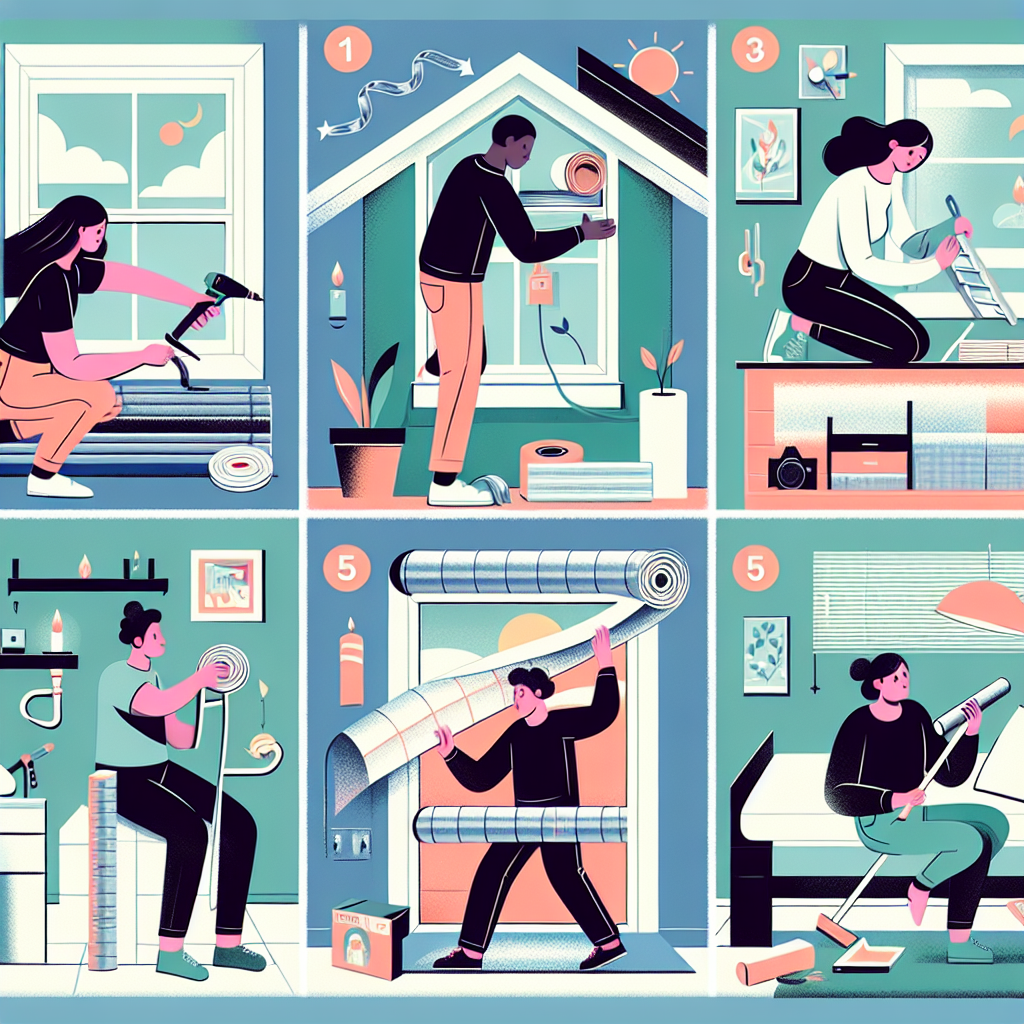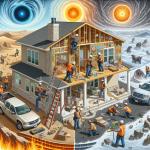How to Improve Home Insulation without Breaking the Bank
-
Table of Contents
Improving home insulation is a cost-effective way to enhance energy efficiency, reduce utility bills, and increase overall comfort. While high-end insulation solutions can be expensive, there are numerous budget-friendly strategies that homeowners can employ to achieve significant improvements. This guide explores practical and affordable methods to enhance home insulation, including weatherstripping, caulking, using thermal curtains, adding insulation to attics and basements, and more. By implementing these techniques, homeowners can create a more energy-efficient living environment without incurring substantial expenses.
DIY Weatherstripping: Affordable Ways to Seal Drafts and Save Energy
Improving home insulation is a crucial step in enhancing energy efficiency and reducing utility bills. One of the most cost-effective methods to achieve this is through DIY weatherstripping. Weatherstripping involves sealing gaps and cracks around doors and windows to prevent drafts, thereby maintaining a consistent indoor temperature. This not only contributes to a more comfortable living environment but also significantly cuts down on energy consumption. By employing a few simple techniques and affordable materials, homeowners can effectively seal drafts and save energy without incurring substantial expenses.
To begin with, it is essential to identify the areas in your home that are most susceptible to drafts. Common culprits include doors, windows, and even attic hatches. A simple way to detect drafts is by holding a lit candle or incense stick near the edges of these areas; if the flame flickers or the smoke wavers, it indicates the presence of a draft. Once you have pinpointed the problem areas, you can proceed with selecting the appropriate weatherstripping materials.
There are various types of weatherstripping materials available, each suited for different applications. For instance, adhesive-backed foam tape is an excellent choice for sealing gaps around windows and doors. It is easy to install, cost-effective, and provides a good seal against drafts. Another popular option is V-strip, also known as tension seal, which is a durable plastic or metal strip that can be used to seal the sides of double-hung or sliding windows. Additionally, door sweeps, which are installed at the bottom of doors, can effectively block drafts from entering through the gap between the door and the floor.
When installing weatherstripping, it is crucial to ensure that the surfaces are clean and dry. This will help the adhesive materials to stick better and provide a more effective seal. Begin by measuring the length of the area you need to seal and cut the weatherstripping material accordingly. For adhesive-backed foam tape, simply peel off the backing and press it firmly into place along the edges of windows or doors. For V-strip, you may need to use small nails or screws to secure it in place. Door sweeps can be attached using screws or adhesive, depending on the type you choose.
In addition to weatherstripping, caulking is another effective method to seal drafts and improve home insulation. Caulk can be used to fill gaps and cracks around windows, doors, and other areas where air may be leaking. Silicone-based caulk is particularly suitable for areas exposed to moisture, such as around windows in bathrooms or kitchens. To apply caulk, cut the tip of the caulk tube at a 45-degree angle and use a caulking gun to apply a steady bead of caulk along the gap. Smooth the caulk with a damp finger or a caulk smoothing tool to ensure a neat finish.
By combining weatherstripping and caulking, homeowners can achieve a comprehensive seal against drafts, thereby enhancing the overall insulation of their homes. These DIY methods are not only affordable but also relatively easy to implement, making them accessible to a wide range of individuals. Moreover, the energy savings achieved through improved insulation can quickly offset the initial investment in materials, resulting in long-term financial benefits. In conclusion, DIY weatherstripping and caulking are practical and cost-effective solutions for sealing drafts and improving home insulation, ultimately contributing to a more energy-efficient and comfortable living environment.
Budget-Friendly Insulation Materials: What to Use and Where to Buy

Improving home insulation is a crucial step in enhancing energy efficiency, reducing utility bills, and maintaining a comfortable indoor environment. However, the cost of insulation materials can be a significant barrier for many homeowners. Fortunately, there are budget-friendly options available that can provide effective insulation without straining your finances. Understanding what materials to use and where to purchase them can make a substantial difference in your insulation project.
One of the most cost-effective insulation materials is fiberglass. Widely available and relatively inexpensive, fiberglass insulation comes in batts, rolls, and loose-fill forms. It is particularly effective for insulating walls, attics, and floors. When purchasing fiberglass insulation, consider visiting home improvement stores such as Home Depot or Lowe’s, which often offer competitive prices and occasional discounts. Additionally, online retailers like Amazon can provide a broader range of options and customer reviews to help you make an informed decision.
Another affordable insulation material is cellulose, which is made from recycled paper products treated with fire retardants. Cellulose insulation is available in loose-fill form and is ideal for attics and wall cavities. It is known for its excellent thermal performance and soundproofing qualities. To find cellulose insulation at a reasonable price, check out local building supply stores or specialized insulation suppliers. These outlets often have bulk purchasing options that can further reduce costs.
Reflective or radiant barrier insulation is another budget-friendly option, particularly for attics. This type of insulation consists of a reflective material, usually aluminum foil, that reflects radiant heat away from the living space. It is especially effective in hot climates where keeping the home cool is a priority. Reflective insulation can be found at most home improvement stores and online marketplaces. When shopping for this material, look for products with high reflectivity and durability to ensure long-term performance.
For those looking to insulate smaller areas or specific problem spots, spray foam insulation can be a cost-effective solution. While professional installation of spray foam can be expensive, DIY kits are available at a fraction of the cost. These kits are suitable for sealing gaps, cracks, and hard-to-reach areas where traditional insulation materials may not be effective. Home improvement stores and online retailers offer a variety of spray foam products, allowing you to choose the one that best fits your needs and budget.
In addition to selecting the right materials, knowing where to buy them can significantly impact your overall expenditure. Local hardware stores often have clearance sections where you can find discounted insulation materials. Additionally, seasonal sales and promotions at larger retailers can provide substantial savings. Online platforms like eBay and Craigslist may also have listings for surplus or leftover insulation materials at reduced prices.
Moreover, consider exploring government and utility company programs that offer rebates or incentives for home insulation projects. These programs can help offset the initial costs and make energy-efficient upgrades more affordable. Websites like the Database of State Incentives for Renewables & Efficiency (DSIRE) provide comprehensive information on available incentives in your area.
In conclusion, improving home insulation on a budget is entirely feasible with the right materials and purchasing strategies. By opting for cost-effective options like fiberglass, cellulose, reflective barriers, and DIY spray foam kits, and by taking advantage of sales, discounts, and incentive programs, you can enhance your home’s energy efficiency without breaking the bank. With careful planning and resourceful shopping, achieving a well-insulated home is within reach for any homeowner.
Simple Window Treatments to Enhance Insulation and Reduce Heating Costs
Improving home insulation is a crucial step in reducing heating costs and enhancing overall comfort, especially during the colder months. One effective yet often overlooked method is through simple window treatments. Windows are a significant source of heat loss in many homes, and addressing this issue can lead to substantial energy savings. By implementing cost-effective window treatments, homeowners can improve insulation without breaking the bank.
To begin with, thermal curtains are an excellent option for enhancing window insulation. These curtains are designed with multiple layers of fabric, including a thermal lining that helps to block out cold air and retain heat within the room. When drawn closed, thermal curtains create a barrier that reduces heat transfer, thereby maintaining a more stable indoor temperature. Additionally, they come in various styles and colors, allowing homeowners to choose options that complement their interior decor while providing functional benefits.
Another practical solution is the use of cellular shades, also known as honeycomb shades. These window coverings are constructed with a unique cellular design that traps air within the cells, creating an insulating layer between the window and the room. Cellular shades are available in different cell sizes and configurations, offering varying levels of insulation. They can be custom-fitted to any window size, ensuring maximum coverage and efficiency. Moreover, cellular shades can be adjusted to allow natural light in during the day while still providing insulation, making them a versatile choice for any home.
In addition to thermal curtains and cellular shades, window film is a cost-effective treatment that can significantly improve insulation. Window film is a thin, transparent layer that adheres directly to the glass surface. It works by reflecting heat back into the room, reducing heat loss through the windows. This treatment is particularly beneficial for older windows that may not be as energy-efficient as modern ones. Window film is relatively easy to install and can be a DIY project for those who prefer a hands-on approach. Furthermore, it does not obstruct the view, making it an unobtrusive yet effective solution.
For those seeking a more traditional approach, heavy drapes can also serve as an insulating window treatment. Similar to thermal curtains, heavy drapes made from thick, dense fabrics can help to block drafts and retain heat. When paired with a liner, they offer an added layer of insulation. To maximize their effectiveness, it is advisable to ensure that the drapes extend beyond the window frame and reach the floor, thereby minimizing gaps where cold air can seep in.
Lastly, draft stoppers or draft snakes are simple yet effective tools for improving window insulation. These are typically fabric tubes filled with insulating materials that can be placed along the bottom of windows to prevent cold air from entering and warm air from escaping. Draft stoppers are an inexpensive solution that can be easily moved and adjusted as needed.
In conclusion, enhancing window insulation through simple treatments such as thermal curtains, cellular shades, window film, heavy drapes, and draft stoppers can lead to significant reductions in heating costs. These methods are not only cost-effective but also relatively easy to implement, making them accessible to a wide range of homeowners. By taking these steps, individuals can improve their home’s energy efficiency and enjoy a more comfortable living environment without incurring substantial expenses.
Read more about Home Insulation
- Types of Home Insulation
- Benefits of Home Insulation
- Choosing the Right Insulation for Your Home
- Common DIY Home Insulation Mistakes
- Insulation for Different Areas of Your Home
- Signs of Poor Home Insulation
- Home Insulation ROI (Return on Investment)
- Upgrading Home Insulation for Extreme Climates
- Maintaining and Updating Home Insulation








